

Half Of All Fundraisers Flee. More than half of all chief development officers (CDOs) recently polled served less than two years in their most recent position, according to a study by Campbell & Company.
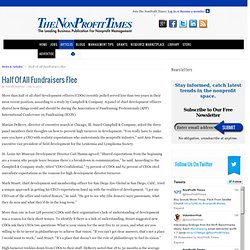
A panel of chief development officers shared how things could and should be during the Association of Fundraising Professionals (AFP) International Conference on Fundraising (ICON). Marian DeBerry, director of executive search at Chicago, Ill. -based Campbell & Company, asked the three panel members their thoughts on how to prevent high turnover in development. “You really have to make sure you have a CEO with realistic expectations who understands the nonprofit industry,” said Amy Franze, executive vice president of field development for the Leukemia and Lymphoma Society. St. Mark Stuart, chief development and membership officer for San Diego Zoo Global in San Diego, Calif., tried a unique approach in getting his CEO’s expectations lined up with the realities of development.
We Just Don’t Have the Money and Other Fibs We Tell Ourselves - Leading for Social Good. We are going down... We have no target! “Welcome aboard ladies and gentlemen… This is your captain speaking… Welcome aboard this flight to somewhere between here and where you actually want to get to.
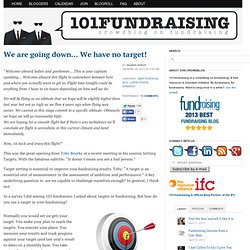
Crowdfunding: It’s Just Fundraising, Right? Are you crowdfunding yet?

Why not? It's the latest craze, and you really should think about getting on board before the asteroid wipes you out ... 'Pay for Performance' Puts Emphasis on Groups Showing Return. Anticipating the growth of social-impact investing, a Boston employment charity has published a study on the societal gains it provides for the dollars it receives, according to The Boston Globe.
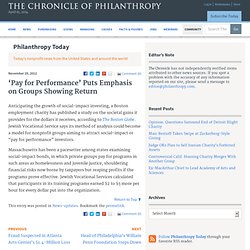
Jewish Vocational Service says its method of analysis could become a model for nonprofit groups aiming to attract social-impact or “pay for performance” investors. Massachusetts has been a pacesetter among states examining social-impact bonds, in which private groups pay for programs in such areas as homelessness and juvenile justice, shouldering financial risks now borne by taxpayers but reaping profits if the programs prove effective. Jewish Vocational Services calculated that participants in its training programs earned $2 to $3 more per hour for every dollar put into the organization. Nonprofit Finances - Where Do Nonprofits Get Their Income? New ways for nonprofits to raise revenue spring into existence every year, but where those funds come from stays pretty much the same year after year.
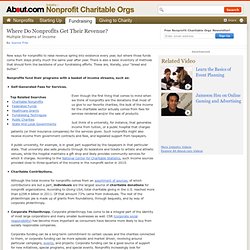
There is also a basic inventory of methods that should form the backbone of your fundraising efforts. These are, literally, your "bread and butter. " Nonprofits fund their programs with a basket of income streams, such as: Self-Generated Fees for Services. Even though the first thing that comes to mind when we think of nonprofits are the donations that most of us give to our favorite charities, the bulk of the income for the charitable sector actually comes from fees for services rendered and/or the sale of products.
Corporate Foundations are private foundations, but their boards are often made up of corporate officers. Ongoing Vs Episodic Funding. Multiyear Grants From Foundations Have Been Dropping Sharply - The Giveaway. In a new analysis of grants by more than 1,400 foundations, the National Committee for Responsive Philanthropy found that multiyear grants to charities dropped by $2.2-billion, or 32 percent, from 2008 to 2010.
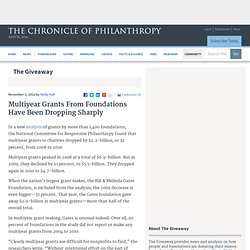
Multiyear grants peaked in 2008 at a total of $6.9-billion. But in 2009, they declined by 21 percent, to $5.5-billion. They dropped again in 2010 to $4.7-billion. When the nation’s largest grant maker, the Bill & Melinda Gates Foundation, is excluded from the analysis, the 2009 decrease is even bigger—33 percent. That year, the Gates foundation gave away $2.9-billion in multiyear grants—more than half of the overall total. In multiyear grant making, Gates is unusual indeed: Over all, 90 percent of foundations in the study did not report or make any multiyear grants from 2004 to 2010. “Clearly multiyear grants are difficult for nonprofits to find,” the researchers write. The analysis follows a recent study that showed a sharp decline in large gifts from individuals.
Demystifying Scaling: Part 1. Financing Not Fundraising: A Social Velocity Blog Series. Great fundraising creative is a process, and every stakeholder has a role to play. Take a fundraising letter.

Any fundraising letter. No, better yet, take a letter that delivered the goods. One that already proved itself with strong results. 'Cash Mobs’ Give Charities a Boost in Donations and Visibility - Ideas & Advice. October 28, 2012 Micah’s Backpack got 120 food items for needy schoolchildren from a cash mob.
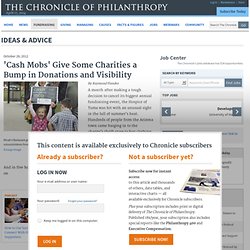
Enlarge Image. Downturn Causes Drop in Multiyear Foundation Grants - Prospecting. Editor’s note: On Thursday afternoon, the National Committee for Responsive Philanthropy withdrew the study that was the basis for the following item.
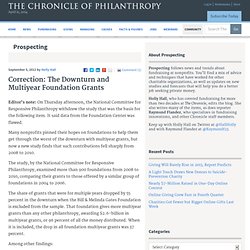
It said data from the Foundation Center was flawed. Many nonprofits pinned their hopes on foundations to help them get through the worst of the downturn with multiyear grants, but now a new study finds that such contributions fell sharply from 2008 to 2010. The study, by the National Committee for Responsive Philanthropy, examined more than 900 foundations from 2008 to 2010, comparing their grants to those offered by a similar group of foundations in 2004 to 2006.
The share of grants that were for multiple years dropped by 55 percent in the downturn when the Bill & Melinda Gates Foundation is excluded from the sample.